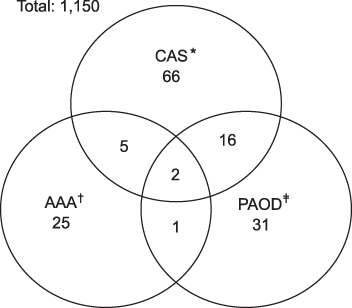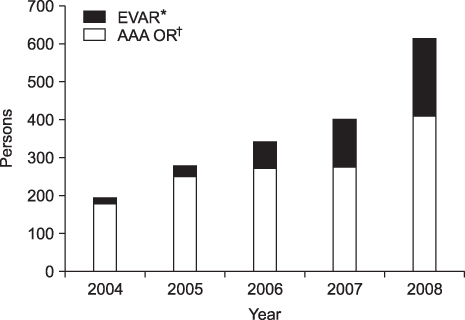J Korean Surg Soc.
2010 May;78(5):305-313. 10.4174/jkss.2010.78.5.305.
Prevalence and Characteristics of Major Vascular Diseases of Elderly Men in the Incheon Area
- Affiliations
-
- 1Department of Surgery, Inha University School of Medicine, Incheon, Korea. keechong@inha.ac.kr
- 2Department of Radiology, Inha University School of Medicine, Incheon, Korea.
- 3Department of Preventive Medicine, Inha University School of Medicine, Incheon, Korea.
- 4Division of Vascular Surgery, Department of Surgery, The University of Pittsburgh School of Medicine, Pittsburgh, PA, USA.
- KMID: 2211957
- DOI: http://doi.org/10.4174/jkss.2010.78.5.305
Abstract
- PURPOSE
As Korea is an aging society (WHO classification) and projected to be an aged society in 10 years, peripheral vascular diseases (PVD) in the elderly population has emerged as an important social and medical issue. But their prevalence was rarely reported in Korea. The purpose of this study is to define the prevalence of carotid artery stenosis (CAS), abdominal aortic aneurysm (AAA), and peripheral arterial occlusive disease (PAOD) of lower limb in the Incheon area.
METHODS
Elderly men (> or =65 years) were referred randomly from the Incheon Federation of Korean Senior Citizens' Association (from Nov 2008 to Sep 2009) to Inha Univeristy Hospital, Incheon, Korea for a PVD screening program. The subjects were screened for CAS and AAA by duplex. CAS was defined as > or =50% internal CAS and AAA as > or =3 cm aortic diameter in minor axis. PAOD of lower limb was screened by measurement of ankle brachial index (ABI); ABI of < or =0.9 was considered abnormal.
RESULTS
1150 subjects were screened including 103 octogenarians (9.0%). Mean age was 72.3+/-0.2 years. Combined conditions were hypertension (54.3%), diabetes mellitus (25.2%), coronary artery disease (15.6%), dyslipidemia (18.9%), obesity (31.1%) and smoking history (71.7%). CAS was detected in 7.7% (89/1,150) subjects. Thirty-three (2.9%) were diagnosed with AAA. PAOD was detected in 50 subjects (4.4%).
CONCLUSION
Prevalence of PVD in Korea is not lower compared to that of western countries, especially the USA and the UK. A nationwide program for timely detection and treatment for PVD should be developed.
Keyword
MeSH Terms
-
Aged
Aged, 80 and over
Aging
Ankle Brachial Index
Aortic Aneurysm, Abdominal
Arterial Occlusive Diseases
Axis, Cervical Vertebra
Carotid Stenosis
Coronary Artery Disease
Diabetes Mellitus
Dyslipidemias
Humans
Hypertension
Korea
Lower Extremity
Male
Mass Screening
Obesity
Peripheral Vascular Diseases
Prevalence
Smoke
Smoking
Vascular Diseases
Smoke
Figure
Cited by 2 articles
-
Case study of abdominal aortic aneurysm screening programs in other countries and feasibility study of a national screening program for South Korea
Sang-Soo Lee, Jin Hyun Joh
J Korean Med Assoc. 2016;59(10):804-812. doi: 10.5124/jkma.2016.59.10.804.Epidemiology of Peripheral Arterial Diseases in Individuals with Diabetes Mellitus
Bo Kyung Koo
J Korean Diabetes. 2019;20(1):10-16. doi: 10.4093/jkd.2019.20.1.10.
Reference
-
1. Criqui MH, Fronek A, Barrett-Connor E, Klauber MR, Gabriel S, Goodman D. The prevalence of peripheral arterial disease in a defined population. Circulation. 1985. 71:510–515.2. Hiatt WR, Hoag S, Hamman RF. Effect of diagnostic criteria on the prevalence of peripheral arterial disease. The San Luis Valley Diabetes Study. Circulation. 1995. 91:1472–1479.3. Selvin E, Erlinger TP. Prevalence of and risk factors for peripheral arterial disease in the United States: results from the National Health and Nutrition Examination Survey, 1999-2000. Circulation. 2004. 110:738–743.4. 2007 Statistics for Elderly Population. 2007. Statistics Korea:5. Anderson CS, Linto J, Stewart-Wynne EG. A population-based assessment of the impact and burden of caregiving for long-term stroke survivors. Stroke. 1995. 26:843–849.6. Fleming C, Whitlock EP, Beil TL, Lederle FA. Screening for abdominal aortic aneurysm: a best-evidence systematic review for the U.S. Preventive Services Task Force. Ann Intern Med. 2005. 142:203–211.7. Cosford PA, Leng GC. Screening for abdominal aortic aneurysm. Cochrane Database Syst Rev. 2007. CD002945.8. Norgren L, Hiatt WR, Dormandy JA, Nehler MR, Harris KA, Fowkes FG. Inter-Society Consensus for the Management of Peripheral Arterial Disease (TASC II). J Vasc Surg. 2007. 45:Suppl S. S5–S67.9. Park KC, Kim DI, Lee SJ, Lee BB, Lee CH, Kim DY, et al. Prevalence of asymptomatic carotid atherosclerosis in Korea. J Korean Soc Vasc Surg. 1999. 15:228–233.10. Lavenson GS Jr, Pantera RL, Garza RM, Neff T, Rothwell SD, Cisneros J. Development and implementation of a rapid, accurate, and cost-effective protocol for national stroke prevention screening. Am J Surg. 2004. 188:638–643.11. Rockman CB, Jacobowitz GR, Gagne PJ, Adelman MA, Lamparello PJ, Landis R, et al. Focused screening for occult carotid artery disease: patients with known heart disease are at high risk. J Vasc Surg. 2004. 39:44–51.12. de Weerd M, Greving JP, de Jong AW, Buskens E, Bots ML. Prevalence of asymptomatic carotid artery stenosis according to age and sex: systematic review and metaregression analysis. Stroke. 2009. 40:1105–1113.13. Lederle FA, Johnson GR, Wilson SE. Abdominal aortic aneurysm in women. J Vasc Surg. 2001. 34:122–126.14. Lindholt JS, Henneberg EW, Fasting H, Juul S. Hospital based screening of 65-73 year old men for abdominal aortic aneurysms in the county of Viborg, Denmark. J Med Screen. 1996. 3:43–46.15. Jamrozik K, Norman PE, Spencer CA, Parsons RW, Tuohy R, Lawrence-Brown MM, et al. Screening for abdominal aortic aneurysm: lessons from a population-based study. Med J Aust. 2000. 173:345–350.16. Ashton HA, Buxton MJ, Day NE, Kim LG, Marteau TM, Scott RA, et al. The Multicentre Aneurysm Screening Study (MASS) into the effect of abdominal aortic aneurysm screening on mortality in men: a randomised controlled trial. Lancet. 2002. 360:1531–1539.17. Shin IH, Im HW. Calculation of Sample Size by Excel in Clinical Research. 2009. 1st ed. Seoul: Gunja.18. Ferguson GG, Eliasziw M, Barr HW, Clagett GP, Barnes RW, Wallace MC, et al. The North American Symptomatic Carotid Endarterectomy Trial : surgical results in 1415 patients. Stroke. 1999. 30:1751–1758.19. Strandness DE Jr. Duplex Scanning in Vascular Disorders. 1993. 2nd ed. New York: Raven Press.20. Winkelaar GB, Chen JC, Salvian AJ, Taylor DC, Teal PA, Hsiang YN. New duplex ultrasound scan criteria for managing symptomatic 50% or greater carotid stenosis. J Vasc Surg. 1999. 29:986–994.21. Ahn YO, Yu KY, Park BJ, Chun JP. Statistics in Clinical Medicine. 2005. Seoul: SNUpress.22. Lee ES, Pickett E, Hedayati N, Dawson DL, Pevec WC. Implementation of an aortic screening program in clinical practice: implications for the Screen For Abdominal Aortic Aneurysms Very Efficiently (SAAAVE) Act. J Vasc Surg. 2009. 49:1107–1111.23. Kim YW, Min SK, Koh YB, Kim SN, Park JS, Moon IS, et al. Report of nation-wide questionnaire survey for abdominal aortic aneurysm treatment in Korea. J Korean Soc Vasc Surg. 2005. 21:10–15.24. Hwang ES, Lee IB, Choi CS. Health insurance, number for current treatment of abdominal aortic aneurysm in Korea (2004-2008). Inha Treatment. 2009. 04. 02. No. 147.25. Obitsu Y. The current management and experience for AAA repair in Japan. 2009. In : 49th Annual Spring Meeting; 2009 Apr 10 - 11; The Korean Society of Vascular Surgery.26. Giles KA, Pomposelli F, Hamdan A, Wyers M, Jhaveri A, Schermerhorn ML. Decrease in total aneurysm-related deaths in the era of endovascular aneurysm repair. J Vasc Surg. 2009. 49:543–550.27. Hwang ES, Lee IB, Choi CS. Health insurance, number for current treatment of carotid artery stenosis in Korea (2004-2008). Inha Treatment. 2009. 06. 22. No. 259.28. Wilmink AB, Forshaw M, Quick CR, Hubbard CS, Day NE. Accuracy of serial screening for abdominal aortic aneurysms by ultrasound. J Med Screen. 2002. 9:125–127.29. Lederle FA, Wilson SE, Johnson GR, Reinke DB, Littooy FN, Acher CW, et al. Variability in measurement of abdominal aortic aneurysms. Abdominal Aortic Aneurysm Detection and Management Veterans Administration Cooperative Study Group. J Vasc Surg. 1995. 21:945–952.
- Full Text Links
- Actions
-
Cited
- CITED
-
- Close
- Share
- Similar articles
-
- Prevalence of Carotid Atherosclerosis in the Elderly
- The Prevalence of Obesity, Abdominal Obesity and Metabolic Syndrome among Elderly in General Population
- The De Facto Mental Illness in Korean Elderly
- A Study on Health Status of Elderly Women in Urban Area
- Prevalence of Preipheral arterial diseases(PAD) used by edinburgh claudication questionnaire among the elderly people in rural communities




